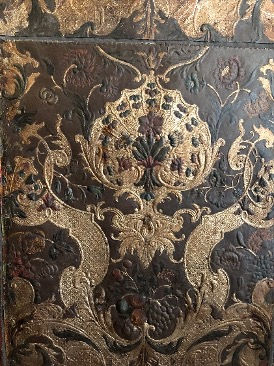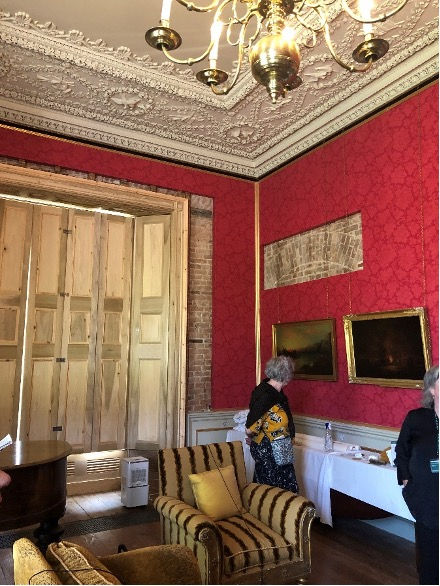The Wallpaper History Society Trip to Ireland May 19-22 2023
- membership200
- Jun 23, 2023
- 6 min read
Eighteen members of WHS descended by bus, coach, car and train on Kilkenny on May 19th to enjoy a tour of some of Ireland’s finest houses and original wallpapers, expertly guided by wallpaper historian and maker David Skinner. This trip, postponed from 2020 by the pandemic, attracted members from as far away as the Netherlands and Boston, USA and it was a pleasure to meet up in person and enjoy several days of viewing exceptional wallpapers and learning from each other, as well as socialising in this warm and welcoming country.


Kilkenny Castle
The first morning took us to Kilkenny Castle. Founded after the Norman conquest of Ireland, the castle was the seat of the powerful Butler family of Ormonde for nine centuries. The castle today is largely a Victorian remodelling of the thirteenth-century defensive castle and stood empty for 30 years after it was abandoned in 1935. It is now run by the Office for Public Works (OPW). After first giving us a historical overview and showing us the amazingly well-preserved wattle and daub ceiling in the tower, our knowledgeable guide handed over to David who took us through the lavishly decorated 18th-century rooms.


The Ladies’ Withdrawing Room featured some original sections of a stunning Chinese hand-painted wallpaper installed in 1801 by Walter Butler, who moved in the social circle of the Prince Regent and shared his taste in wallpaper (as evidenced by similar papers existing in the Brighton Pavilion). Typical bird and plant motifs climb the paper to a grand tasselled border at the top. David explained that it was originally painted in Canton and was a laminate of three layers – two bamboo pulp layers as a base topped by a very fine paper like cigarette paper.


David has been involved in wallpaper restoration at the castle, reprinting a Regency Gothic wallpaper imitating carved stonework and restoring some eighteenth-century gilt leather wallpaper panels. He explained the challenge of dealing with the hygroscopic qualities of the leather panels. As they retain moisture, they expand and contract and so can tear from their nail fixings. David ingeniously resolved this by joining the panels with linen and attaching them with Velcro onto elasticised fittings in order to cope with changes in humidity.


On the ground floor of the Castle the OPW has installed a fascinating wallpaper gallery featuring papers from the eighteenth century to the 1970s, curated by David and drawn from his collection of over 250 wallpapers from Irish houses. Unsurprisingly this proved particularly absorbing for WHS members.



Block-printed, Dublin, 1755-1765 / Hand-painted, China, c 1850 /
Block-printed with stamped gold foil, 1860-1870
We concluded the day at Dangan Cottage near Thomastown where owner and eighteenth-century interiors expert Christopher Moore entertained us to tea and scones and showed us his wonderful collection of tapestries, paintings and artefacts including some fascinating papier mâché paintings of birds and flowers produced by Samuel Dixon in the 1740s. Among his treasures, many hunted down at auction, were some framed Chinese wallpapers laid on top of a trellis design that member Jo Banham later identified as being the same as the trellis paper designed by Robert Jones for Crace & Sons and used at the Brighton Pavilion. The exceptional interior of his house by the river had WHS members swooning and vowing to sell up and move in…



Christopher Moore (in blue shirt) shows us fragments of wallpaper at Dangan Cottage
The following day we headed off to The Swiss Cottage, near Cahir in County Tipperary, a delightful thatched cottage orné considered to be one of the best preserved in Europe. It was built in the early 1800s for Richard Butler, 1st Earl of Glengall, probably by John Nash, as a place to enjoy hunting and picnics and indulge in an idyllic fantasy of rural life.

WHS members at The Swiss Cottage
In one room we were able to view, but not photograph, a fine example of a panoramic paper from 1812 by French company Dufour entitled ‘Banks of the Bosphorus’, a design still available today.

Dufour ‘Banks of the Bosphorus’ panoramic wallpaper
The intricacies of these designs meant that thousands of blocks were need in the printing process to render all the details and hence the papers were extraordinarily expensive. Here, areas of missing paper had been expertly painted in by contemporary painter Garth Benton. The remainder of the house had undergone an exuberant refurbishment in the 1980s led by renowned interior designer Sybil Connolly who revived the 18th-century spirit with trellis and geometric wallpaper designs as well as a striking toile de Jouy paper in one of the bedrooms. As David pointed out, this was a design style that actually originated in Ireland and was taken up by the textile manufacturers of Jouy who made it their own.


Doneraile Court
In the afternoon we arrived at Doneraile Court in County Cork, an imposing late seventeenth-century house with many subsequent additions. It was built for the St Leger family who gave their name to the famous horse race and has recently been the subject of major restoration works by the OPW. The house was notable for escaping plunder and burning during Irish Civil War in the 1920s because of the generosity shown by the family, who supplied the local community with produce from the estate at a time of hardship and famine.

A fine example of David’s restoration work is on display in one of the bedrooms, featuring a vibrant blue and white wallpaper thought to be originally from the 1830s or ‘40s.

The OPW has installed a display of historic wallpapers in the house, including these fragments of wallpaper made in England from the 1920s to the 1970s and sold by O’Shea’s shop in Fethard, County Tipperary.

WHS members at Fota House
The following day, after a morning at leisure in the fine city of Cork, we headed for Fota House, the ancestral home of the Smith Barry family and a fine example of Regency architecture. The house was remodelled in opulent style by renowned Irish architects Sir Richard Morrison and his son William Vitruvius Morrison to create a suitable environment for entertaining and also boasts a beautiful arboretum and formal gardens.



After passing through a striking atrium lined with marbled neoclassical pillars, we explored the house and its many examples of rooms decorated with historic and reproduction Irish wallpapers. Designs included shamrocks, blue roses and Regency stripes, as well as a rich red floral in the drawing room, the original having been purchased in the 1970s from London firm Cole and Son. This was possibly a design that originated with the earlier firm of Duppa, Slodden & Co. Here, sections of the wall have been exposed (due to dry rot) revealing some of the original construction details of the house. The new wallpapers are David’s meticulous work.

Drawing Room, Fota House, showing exposed brickwork
In each case a fragment of the original paper has been preserved for comparison, such as in the nursery, where the nursery rhyme paper is based on Walter Crane illustrations but lacks their detail and finesse.

In the warren of ground-floor corridors was an excellent display providing a history of Irish wallpaper illustrated by examples from Ireland’s first archive of historic wallpapers, amassed by the architect and conservationist John O’Connell from the 1970s onwards. Among this archive are some unused rolls of 19th-century hand-printed wallpapers, thought to be stock from leading Dublin decorator Henry Sibthorpe & Son.

The Chinese room at Mount Congreve
By our last morning, now in Waterford, we were starting to feel that what we had seen so far couldn’t be bettered. But Mount Congreve was a revelation. Built in the eighteenth century as the seat of the Congreve family, it was remodelled in the 1960s by its last owner, Ambrose Congreve, who not only created a world-famous garden, but also designed a Chinese-themed banqueting room specially to display some original unused 1790s Chinese wallpaper, hand-painted in Canton. This glorious paper, its colours singing as if newly applied, featured scenes of Chinese life and industry, including rice-growing and silk-weaving.

Each scene was cut into a background of bamboo trellis and set at eye level like a series of prints running round the room. Above and below, an abundance of flowers burst from hanging baskets and urns. Wallpapers such as these were brought over to Britain by the East India Company, who were adept at translating western tastes into Chinese designs. Displaying this costly paper was a demonstration of the owner’s wealth and status. The papers are considered by Emile de Bruijn, author of Chinese Wallpaper in Britain and Ireland, to be exceptional.


After this grand finale to the trip it was time to say our goodbyes and head for home. It was a privilege to have had access to so many wonderful examples of wallpaper and enrich our knowledge, whilst enjoying great camaraderie and social time together. We could not have wished for a more inspiring and well-planned tour and our thanks go to organisers Zoe Hendon, Wendy Andrews and Rowena Beighton-Dykes and our outstanding guide and tutor David Skinner.
Lucy Ellis
All photos by the author and members of the society unless otherwise stated
